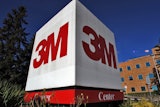
More than four years after announcing plans to build a major U.S. petrochemical complex, Shell this week made it official: the energy giant will begin construction on a site near Pittsburgh in 18 months' time.
The multi-billion dollar Appalachian petrochemical project comes amid a time of otherwise sweeping cuts for Shell, and local officials believe it could significantly help western Pennsylvania's beleaguered industrial sector.
"This announcement signals Shell’s re-entry into the North American polyethylene market. The plant will be one of the largest of its kind in North America — the largest single 'from the ground up' industrial investment in the Pittsburgh region in a generation — and the first major U.S. project of its type to be built outside the Gulf Coast region in 20 years," Dennis Yablonsky, CEO of Allegheny Confernce on Community Development, an affiliate of the Pittsburgh Regional Alliance, said in a statement.
Here's a look at the project, by the numbers:
$6 billion: The estimated price tag of the complex, which would be the first major U.S. project of its kind to be built outside the Gulf Coast in 20 years. The complex will be built on the site of the former Horsehead Corp. zinc smelter in Monaca, Penn., about 30 miles northwest of Pittsburgh along the Ohio River. It will include an ethane cracker, three polyethylene units, and power, water and storage and logistics facilities.
600 = The estimated number of permanent employees at the plant once it's completed early in the next decade — a number that prompted Pennsylvania's governor to call the decision "game-changing." The Monaca area once hosted numerous steel mills, and even the shale gas industry has been hit hard in recent years as producers struggled to adjust to low energy prices. The project is also expected to generate up to 6,000 construction jobs, and some experts believe the jobs impact in the region will reach into the tens of thousands.
1.6 million = Anticipated capacity, in tons, of the plant's annual production of polyethylene. The cracker plant would utilize massive nearby natural gas reserves to convert the feedstock chemical ethane into polyethylene, which is used to make everything from plastics and textiles to auto parts and pharmaceuticals.
700 = It's no coincidence that Shell picked Appalachia for the massive project. Not only does Pittsburgh lie atop both the Marcellus and Utica shale formations, but 70 percent of all polyethylene customers in North American live within a 700-mile radius of the city. Shell officials said that the plant and its customers will experience a shorter and more reliable supply chain — particularly compared to facilities on the Gulf Coast.
$1.6 billion = The estimated value of state tax credits over a 25-year span awarded by Pennsylvania lawmakers to Shell in 2012. Analysts said the credit amounts to $2.10 per barrel of ethane, or 20 percent of its overall tax liability. Tom Corbett, the governor at the time, pushed hard for the credits as the state competed with neighboring Ohio and West Virginia for the plant. Some lawmakers, however, were hesitant to embrace tax subsidies following a controversial state budget. Other critics remain opposed today because of environmental concerns.























